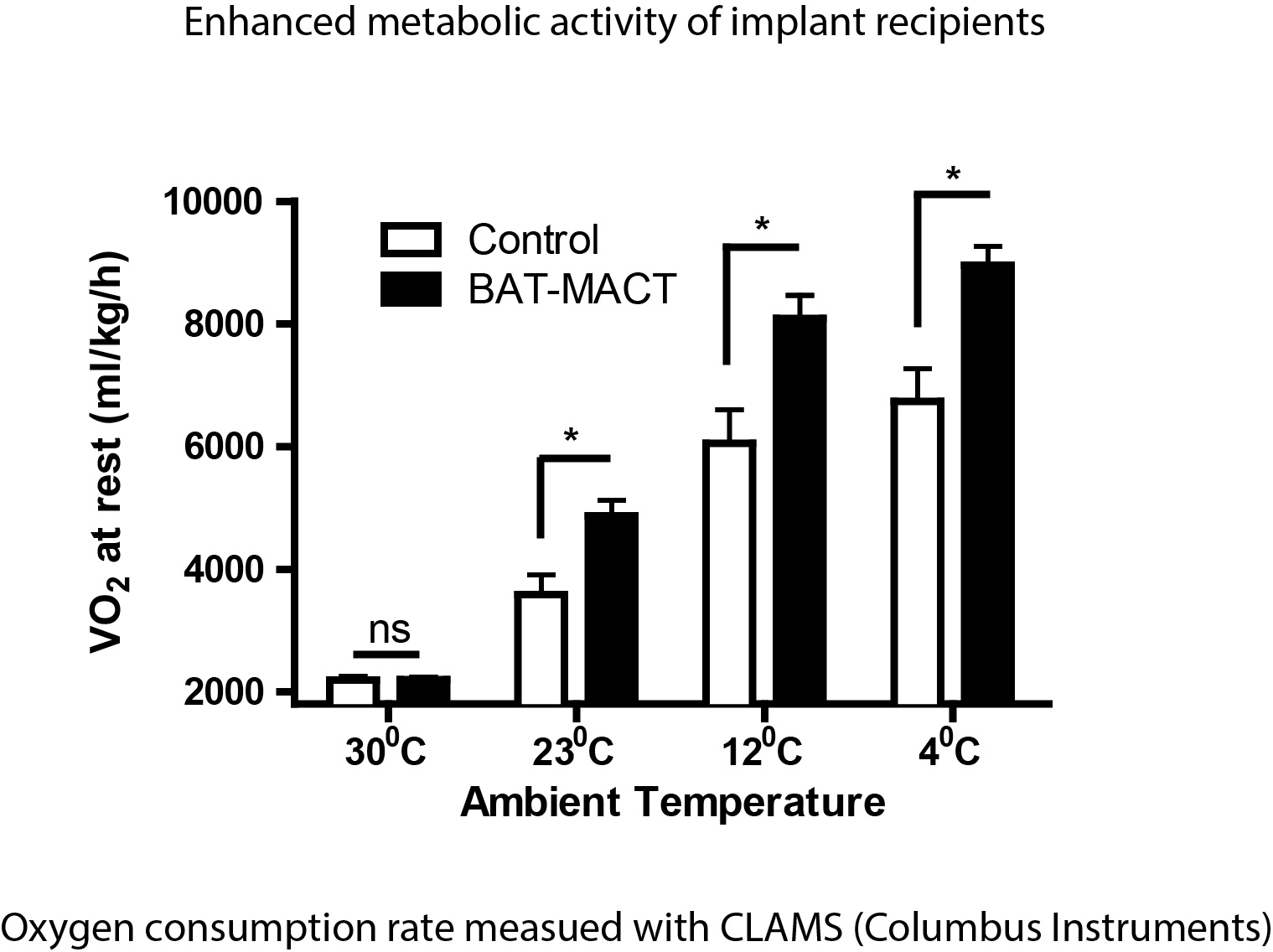Introduction: Novel, clinically relevant approaches to shift energy balance are urgently needed to combat metabolic disorders such as obesity and diabetes. One promising approach has been the expansion of brown/beige-adipose tissues that express uncoupling protein 1 (UCP1) and that decouples mitochondrial respiration from ATP synthesis and in turn drastically increases metabolic rates for thermoregulation (heat production)[1],[2]. The transplantation of brown fat in small animal model systems has demonstrated that exogenous brown fat expansion is an effective method to combat metabolic disorders. Expansion and/or stimulation of UCP1-positive adipose has demonstrated physiologically beneficial reductions in circulating glucose and lipids but there are no sources of transplantable brown fat for human therapeutic purposes. To circumvent this barrier, we present a novel cell scaffold technology optimized to induce “browning”, differentiation of white fat progenitor cells into brown fat-like cells[3]. This injectable hyaluronic acid based hydrogel system, termed BAT-MACT (beige adipose tissue – matrix assisted cellular transplant), establishes functional brown fat-like depots in vivo and induces improvements in the metabolic profiles of the recipients.
Materials and Methods: We adapted the biophysical properties of hyaluronic acid-based hydrogels[4],[5] to support the differentiation of white fat derived multipotent stem cells (ADMSCs) into lipid accumulating, UCP1 expressing beige adipose tissue. Specifically, two peptides (CGGKAFDITYVRLKF and CGGRKRLQVQLSIRT) were covalently linked to a hyaluronic acid backbone at a molar ratio of 3:1. ADMSCs differentiated into beige adipocytes were suspended in the optimized hyaluronic acid framework, crosslinked with an MMP-13-cleavable peptide (CQPQGLAKC), and injected into recipient mice. The viability of implanted cells and metabolic profiles of the recipients were thoroughly monitored and examined.

Results and Discussion: Subcutaneous implantation of ADMSCs within optimized hydrogels resulted in the establishment of distinct UCP1-expressing implants that successfully attracted host vasculature and persisted for several weeks. Importantly, implant recipients demonstrated elevated core body temperature during cold challenges, enhanced respiration rates, improved glucose homeostasis, and reduced weight gain - demonstrating the therapeutic merit of this highly translatable approach.

Conclusion: This novel approach is the first truly clinically translatable system to unlock the therapeutic potential of brown fat-like tissue expansion and demonstrates the merit of bioengineered tissues for metabolic therapies. And, unlike the pharmacological browning of white adipose depots, the implantation of bioengineered beige adipose tissues offers a spatially and temporally controlled therapeutic. The BAT-MACT system provides a non-immunogenic platform to expand beige adipose tissue through immobilized synthetic physical cues, which carries a significantly lower risk of off target effects relative to administration of “browning” factors. Additionally, by relying on the trans-differentiation of white fat derived ADMSCs, a highly abundant cell population, there are few limitations on the amount of implantable organoids that can be generated for clinical deployment with the BAT-MACT technology.

References:
[1] Boss O, Farmer SR. "Recruitment of brown adipose tissue as a therapy for obesity-associated diseases." Front Endocrinol (Lausanne) 2012;3:14.
[2] Rosen ED, Spiegelman BM. "What we talk about when we talk about fat." Cell 2014;156:20-44.
[3] Wu J, Bostrom P, Sparks LM, Ye L, Choi JH, Giang AH, Khandekar M, et al. "Beige adipocytes are a distinct type of thermogenic fat cell in mouse and human." Cell 02012;15:366-376.
[4] Xu X, Jha AK, Harrington DA, Farach-Carson MC, Jia X. "Hyaluronic Acid-Based Hydrogels: from a Natural Polysaccharide to Complex Networks." Soft Matter 2012;8:3280-3294.
[5] Burdick JA, Prestwich GD. "Hyaluronic acid hydrogels for biomedical applications." Adv Mater 2011;23:H41-56.